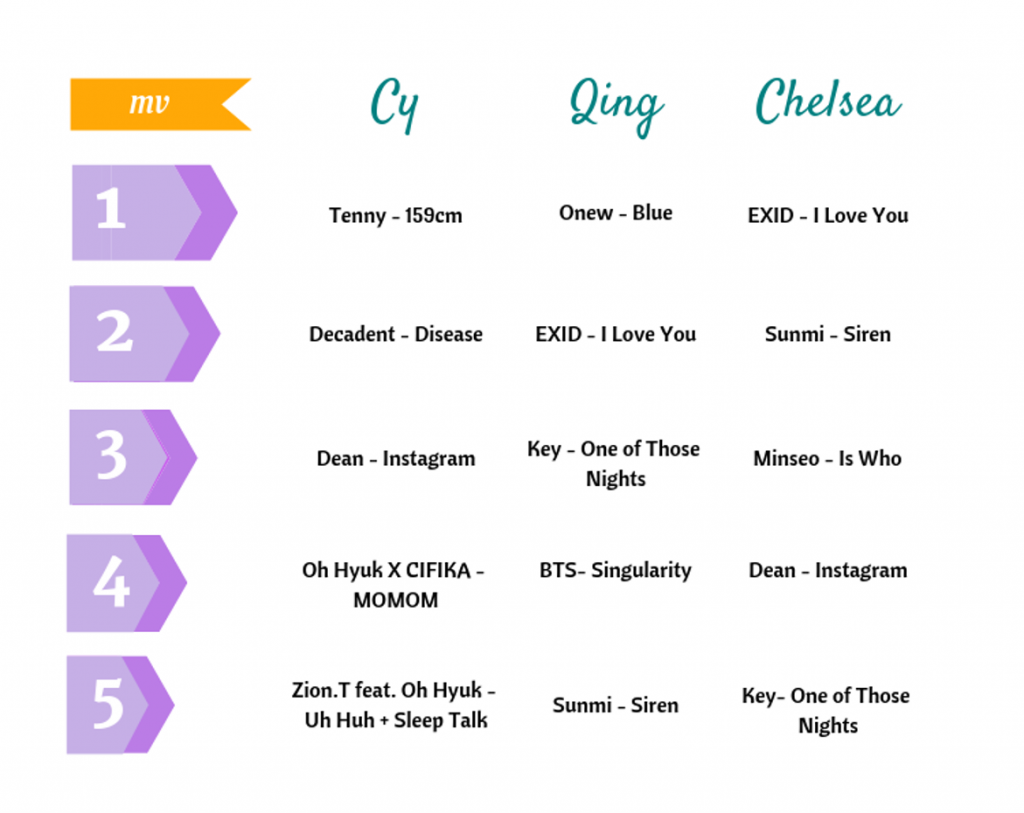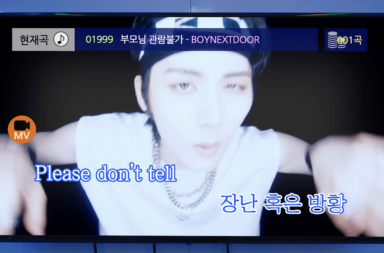
Kicking off the annual Seoulbeats End-of-Year Review are Camiele (Cy), Chelsea, and Qing, who come together to discuss the imaginative music videos that stood out from the crop this year. They find themselves with a balanced selection of pop and indie releases with charming visuals and emotional messages that resonate.

Cy: This year was definitely one for videos that were aesthetically complex for the sake of making very poignant statements. I had a hard time deciding which MVs I wanted here, so let it be known that there were quite a few ties in this list, and it was something intangible that had me choose one MV over the other.
Qing: It’s great that we have a mix of pop and indie releases. Like you, Cy, I had a lot of trouble ranking my picks. In the end, I prioritised those with creativity and more accessible content. Chelsea, I see we have a few picks in common. Shall we start with EXID?
Chelsea: “I Love You” was everything I wanted their past two comebacks to be, and the MV had the kind of whimsy that I didn’t see in “Night Rather than Day.” Aside from the fantastic choice of bold colors and cartoonish sets, what I love the most is that the EXID members aren’t afraid to poke fun at themselves. Comparing getting over a break-up to a hangover is also a clever metaphor that gave them a lot of room to be playful and show their support for one another — even when they’re all making bad choices.
Qing: K-pop churns out so many MVs a year that it’s not easy to have a fresh idea and execute it well. “I Love You” was a delight to watch, re-watch, and re-watch: it’s creative, a little crazy, easy to understand, and very, very funny.

You’re treated to EXID’s polished image and charisma as they deliver sharp dance moves, but there are also all these scenes of them breaking down individually. The contrast not only brings out humour, but also a more human side to them. Regardless of whether they’re performing or wailing over their ex, there’s a confidence to how honest and present they are in the moment.
Cy, your picks also seem very creative and varied in style. What drew you to them?
Cy: Well, I’m a sucker for the outrageous and esoteric. Three of my five videos just took me all the way back to ’90s MTV, Liquid Television — weird and wonderful. Decadent’s “Disease” MV and Oh Hyuk and CIFIKA’s collaboration “MOMOM” recall the exact aesthetic that I grew up with watching MTV and Nickelodeon shows. The use of clay animation (“Disease”) and jarring disparate images (“MOMOM”) tickles something in my brain that both excites, frightens, and confounds me. I can’t help it. MVs like that are just my thing.
On top of all that, I like digging into the images of a video, to sift through all the imagery and see how everything connects. This, obviously, means Dean’s “Instagram” was just ripe with everything I adore: imagery, intertwined messages, and a visual narrative that’s tied intrinsically with the lyrics. Dean really was out to murder me this year with his solitary video release! What about “Instagram” had it make your list, Chelsea?

Chelsea: For me, it was the balance of simple aesthetics with a deep message. At first, the MV feels mopey and stagnant. But then as the white walls transform into a screen, the set comes alive. Even without choreography, or even a traditional narrative movement, Dean managed to really communicate the relationship between social media, art and isolation. Like Janine said in her review, it’s a very complex — personal — message that is masterfully done with skillful camera work and an excellent curation of projected images.
Looking at the rest of your list, Cy, some of your selections are new discoveries for me. Especially the Tenny MV — I can’t believe I missed it. I really love the combination of vintage filming and inclusion of a queer romance we often don’t get to see in Korean MVs. Though 2018 definitely saw more doors opened with artists like Holland, and more narratives explored with MVs like Taeyeon and Melomance’s “Page 0,” and Jaurim’s “있지.” What about the Tenny MV put it at the top of your list?
Cy: It was precisely that the female queer relationship wasn’t oversexualized, it wasn’t perpetuated for a male gaze. It was innocent and adorable love between two women. However, it painted a very real picture of what it means for gay women in particular to navigate a contemporary world culture that very much still views the woman as subordinate and without any agency, sexual or otherwise. I love the aged aesthetic, the inclusion of a story, though sort of on the dramatic side of narrative, still very relevant.
Even more than that, I love the way these two women triumphed and overcame their abuse and ostracization. It was a powerful statement about literally taking matters into your own hands and fighting for what you want. When something is that in-your-face and unapologetic, I can’t help but be moved by it.
Indie artists in particular in SK have that agency, that ability to take on topics that matter to them, and further to tackle challenging and creative imagery however they choose. They are, after all, completely beholden to their own budgets, thus their own imaginations. This often means enlisting friends and acquaintances to help out.
In the case of Decadent, claymation isn’t a common medium for most modern music videos. The use of this bygone niche of animation alone makes it stand out among so many music video releases. They were able to take the literal image of disease and how it affects the body and the mind to explore the themes of isolation, depression, and overwhelming loneliness.
I have a soft place in my heart for indie artists, I won’t deny it. Mostly because they dare to be more, to reach for more. One could argue they have more license to do so, but honestly lack of resources is the mother of invention. The videos they concoct when pressed for it really are quite spectacular.
Qing: That’s a good point about indie artists and artistic freedom, Cy. K-pop MVs are still taking baby steps to venture beyond familiar topics such as heterosexual romance. That it’s rare to find K-pop MVs tackling alternative topics is what landed Onew’s “Blue” at the top of my list.
The song is about loneliness and feeling blue, and is marked by a lovely ambivalence—“Blue night / Calling me from far away / Is it light or is it darkness?” The MV takes visual and mood cues from blueness. But in place of the ambivalence in the lyrics is a pressing sense of lethargy and quiet despair that expresses the experience of living with depression.
What stands out most, other than the austere, blue-toned colours drained of vibrancy, is the motif of evenness. The movements of the camera and Onew are slow and measured, as if neither have the energy to move faster or vary the speed at which they move. Even a shooting star forms a perfect parallel with the horizon; nothing is askew.
There’s also the sense of detachment from other people, conveyed in the chilling image of a couple and a family turning to face Onew, their faces blindfolded, unreadable, unreachable. When Onew finally snaps out of his trancelike state to show surprise and shock, he finds that time has elapsed, and his home, his safe space, has become decrepit. The imagery of “Blue” is presented in such an intensely understated way that it socks you right in the gut.
“Blue” certainly cannot be fully representative of the varied experiences of depression. Still, it’s a very nuanced and intense work that draws attention to some emotional states that a person living with depression struggles with. It’s an unusual topic for mainstream K-pop MVs, and a very important one that I hope other releases will continue to explore.
Cy: Powerful imagery was certainly a common thread for all our choices. When we go back to consider the motif of the power and agency of women, I have to shout out Minseo’s “Is Who,” even if it didn’t make my final list. It was sitting on my extended list of about 10-12 videos for a long time. Puppetry is also an untapped medium for MVs.
I think why it fell short for me is because I don’t feel it fully embraced the theme of the puppet show as an alternate reality, instead opting to incorporate choreography scenes to keep it more in line with an idol aesthetic. Nothing wrong with it at all, but it did take away from what I thought could’ve really been something spectacular.
Chelsea: The bohemian, minstrel show feel of Minseo’s “Is Who” is what really got me. It’s also a concept not often embraced in K-pop, at least not so fully. The colors were wonderful, the foliage, the full band; I appreciate all of it. I have to admit, puppets freak me out a little, but I loved that the puppet movements were incorporated into the choreography — even if you’re right that the idea of a puppet double could have been more embraced. The MV had a very cohesive feel, and made a strong statement for Minseo who is still finding her footing between the idol and artist concepts.
The idea of doubles and alternate realities also seemed to be a theme in solo female MVs this year. In addition to Minseo, there was Olivia Hye’s “Egoist” and Sunmi’s “Siren” — which made both Qing and my lists. Beyond the quirky signature of Sunmi’s post-JYP MVs, there’s a lot to unpack in “Siren” — particularly the parallel of cages and domestic spaces. What’s your take, Qing?
Qing: “Siren” is such a puzzle, and so unmistakably Sunmi. The strong self-reflexive element in the doppelganger motif was fascinating. Homebody Sunmi keeps running into performer Sunmi, and as this situation repeats, it produces a bizarre humour with undertones of creepiness. It’s like Sunmi can’t quite wrap her head around the part of her that’s an artist.
If “Gashina” was about dramatizing some of her personality quirks and intertwining that with her persona as a performer, “Siren” is a clever continuation, the flip side of the coin that acknowledges a split in her identity.
Chelsea: I really appreciate the way that split was portrayed: between how the human Sunmi sees herself in private, and how the public’s image (or images) of her continuously invade that space. It’s the little details though, like the throwbacks to previous episodes of the trilogy, the priority sticker in her hair, and the washing machine that really made this video stand out for me. I liked that the idea of a siren was adapted to the domestic space, with this idealized form of Sunmi sitting on a washing machine at the bottom of the ocean. Is it weighing her down, or is it part of the image someone else may hold of her?
There’s a lot of subtle commentary on Sunmi’s public image, and how she feels trapped without going overboard. Of course there’s the obvious symbolism of the cage, but even her own house is surrounded by caution tape when she tries to escape. In the end, she doesn’t actually escape her house and all the other Sunmi’s, but seems to embrace them. Overall, “Siren” served as a great conclusion (or technically prequel?) to a wonderfully quirky trilogy.
Cy: Identity also seems to be a common theme in our choices. With Dean’s “Instagram,” it’s this sense of internal isolation despite (possibly) millions of people interacting with the image of you they see from the snippets you give on your social media pages. In “Disease” and “Blue,” the concept of losing who you are in the throes of depression or extreme sadness. In “159cm,” owning who you are and fighting for that at all costs. In “Siren” and even “Is Who,” parsing through the many sides of yourself and realizing they’re all pieces to your personal puzzle.
Though the video eventually didn’t make my final list, I also had V’s “Singularity” on my longer list. The imagery is just breathtaking and incredibly unique to what you do see in K-pop MVs, a step closer to how most indie artists inherently think outside the box to express themselves completely. I believe Love Yourself: Tear taps into themes of identity and defining one’s self. “Singularity,” even in just the title, played into that message so well, particularly when you dig into the imagery of the mannequins and how they’re really just the dancers themselves playing the role of a significant other (thus giving the inanimate object agency through their own personalities), the masks, etc. What about “Singularity” struck you so much, Qing?

Qing: It wasn’t an immediate knockout, but the way that “Singularity” gives visual form to the lyrics and the musical colour of the song made it an enduring watch.
There’s play with light and shadow, and shifts in colours of the lighting, that reflect the solitude, the haunted mood of the song. There’s an echoing synth anchoring the song that evokes a sense of empty space. It finds its visual twin in the vast, James Turrell-esque sets that engulf V. Then there are the masks and coat stands you’ve mentioned, Cy, and also the subtle incorporation of allusions to the Narcissus and Echo myth and the painting of Ophelia that cement the message of the lyrics.
Chelsea: It wouldn’t be a year end list for me without some inclusion of Shinee. And while Shinee gave us a lot of a great content this year — ripe with emotion and musical experimentation — it was Key’s “One of Those Nights” that took top honors for MV. Qing’s review already touched on all of the strengths of “One of These Nights,” but what stood out for me with this MV was not the plot, or the overall theme, but the production.
The color palette was warm, there was a haze without it being too soft-focusey, and the mood was appropriate for the track. I like that watching it felt like being suspended in time — just like the longing Key’s singing about — and the way the sets rotated through past and present. There was a really nice contrast between motion and stagnation, and I liked the way the sets and Key himself played into that dichotomy.

“One of Those Nights” stepped out of the traditional SM box, and honestly, was a lot more than I expected SM to give Key after the pre-release “Forever Yours.” Finally, my Shinee bias got some of the spotlight he deserves. That basically sums up my list this year: MVs that chose smart concepts to highlight an artist’s strengths in new, imaginative ways — with or without actually breaking free of the soundstage filming set.
Qing: You’ve expressed the strengths of Key’s MV beautifully, Chelsea. Looking again at my picks, this has been a great year for MVs that visually portray a range of emotional states. I’ve said plenty on this subject in my review of Key, but it’s worth noting once again that MVs are really pushing film techniques and creative concepts to a new level to this purpose.
Cy: For my final thoughts, I simply want to say I’m glad that so many artists are attempting to step up the visual game in meaningful, poignant ways.
(YouTube. Images via Banana Culture Entertainment, Big Hit Entertainment, Joombas Music, Make Us Entertainment, SM Entertainment)


